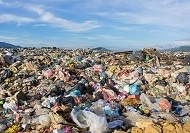Jan 10 2019
To reduce the risk of fire, many everyday products –– from building materials to furniture to clothing –– contain flame retardants. In recent years, some of these compounds were shown to have harmful effects on the environment, causing them to be replaced by more eco-friendly alternatives. However, a new study in ACS' journal Environmental Science & Technology, indicates that heat or ultraviolet light could break down a "safe" flame retardant into potentially harmful compounds.
 Safe' flame retardants could break down into potentially harmful compounds from exposure to the sun's ultraviolet light at landfills. (Credit: Nokuro/Shutterstock.com)
Safe' flame retardants could break down into potentially harmful compounds from exposure to the sun's ultraviolet light at landfills. (Credit: Nokuro/Shutterstock.com)
Some brominated flame retardants, such as hexabromocyclododecane (HBCD), persist and bioaccumulate in the environment, potentially having toxic effects on organisms. As a result, some international regulatory bodies have banned HBCD, which is commonly used in polystyrene foam insulation. A replacement for HBCD, polymeric flame retardant (polyFR) is a large polymer that it is much less likely to enter cells or accumulate in the food chain. Although polyFR is considered a more environmentally friendly flame retardant, the long-term behavior of the chemical is unknown. So Christoph Koch, Bernd Sures and colleagues examined whether heat or ultraviolet light — which could be encountered during the product's use as insulation in a hot attic or after its disposal in an open landfill — could break down polyFR into smaller, potentially more harmful substances.
To simulate different environmental conditions polyFR might encounter during its lifetime, the researchers exposed the flame retardant powder to heat (140 F) or ultraviolet light and analyzed the samples with mass spectrometry. When the researchers irradiated polyFR with ultraviolet light for 3 hours, they detected 75 different degradation products, including eight containing bromine. In contrast, heat treatment for 36 weeks yielded only seven degradation products, one of which contained bromine. Because some of the detected compounds were small and brominated, they have the potential to be harmful, say the researchers. The team notes that polyFR may degrade differently when incorporated with polystyrene into foam insulation.
The authors do not acknowledge any funding sources